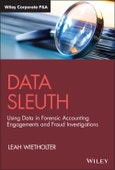In Data Sleuth: Using Data in Forensic Accounting Engagements and Fraud Investigations, certified fraud examiner, former FBI support employee, private investigator, and certified public accountant Leah Wietholter delivers a step-by-step guide to financial investigation that can be applied to almost any forensic accounting use-case. The book emphasizes the use of best evidence as you work through problem-solving data analysis techniques that address the common challenge of imperfect and incomplete information.
The accomplished author bridges the gap between modern fraud investigation theory and practical applications and processes necessary for working practitioners. She also provides: - Access to a complimentary website with supplementary resources, including a Fraud Detection Worksheet and case planning template - Strategies for systematically applying the Data Sleuth® framework to streamline and grow your practice - Methods and techniques to improve the quality of your work product
Data Sleuth is an indispensable, hands-on resource for practicing and aspiring fraud examiners and investigators, accountants, and auditors. It’s a one-of-a-kind book that puts a practical blueprint to effective financial investigation in the palm of your hand.
Table of Contents
Foreword xi
Preface xv
Acknowledgments xix
Chapter 1: Building a Data Sleuth Team 1
The First Team 2
The Forensic Accountant 4
Technical and Strategic 4
Thorough and Efficient 5
Detail-Oriented and Effective Communication 6
Accounting Knowledge and Legal Knowledge 7
Meeting Deadlines and Developing Business 8
Forensic Accountant Problems 8
The Scalability Problem 9
The Strategy Problem 10
The Review Problem 12
The Sustainability Problem 13
Data Sleuth Solutions 14
The Scalability Solution 14
The Strategy Solution 16
The Review Solution 18
The Sustainability Solution 18
Chapter 2: The Data Sleuth Process 21
Engagement Types 21
Simultaneously Managing Client Expectations and Objectivity 25
Professional Standards 28
The Data Sleuth Process 30
Chapter 3: The Data Sleuth Necessity 41
Forensic Accounting Engagements versus External Financial Statement Audits 42
The Evolution of Forensic Accounting 44
The Case of the Cash Back Payroll Scheme 45
Start with the Evidence, Not the Scheme 47
The Case of the Gambling Executive Director 48
Chapter 4: Data Sleuth Considerations 53
Investigations Affect Real People 54
The Case of the Nonexistent Inventory 55
The Fraud Formula 58
Staying on Task with Purpose in Mind 59
The Investigation Decision Tree for a Data Sleuth 60
Recovery Avenues 63
The Case of the Man Cave 66
Chapter 5: Client Communication and Involvement 71
The Case of the Initial Client Meeting 72
Client Expectations 75
Data Procurement 77
Client Involvement During an Investigation 78
Ongoing Client Communication 81
Chapter 6: The Data Sleuth Case Plan 83
The Data Sleuth Process 83
The Client’s Investigation Priorities 86
Evaluate the Subject’s Access through Risk-Based Analysis 86
Data Sleuth Analysis Framework 88
From Conceptual Venn Diagram to Comparative Data Analysis 96
The Data Analysis Plan 97
Data and Information Gathering 99
Communication of the Case Plan 101
The Case of the Duplicate Payroll - Conclusion 102
Chapter 7: Risk-Based Analysis 105
The Case of the Puzzling Entries 106
Risk Focus in Audits versus Risk Focus in Investigations 118
The Case of the Mom of the Year 118
Evaluating Risk in Divorce Cases and Estate and Trust Disputes 126
Chapter 8: Data Sources and Data Processing Techniques 129
Data Sources Explained 129
Quantitative and Qualitative Data Sources 130
Data Sources for Quantitative Evidence 130
Data Sources for Qualitative Evidence 134
Using Quantitative and Qualitative Data Sources 135
Data Processing Techniques 136
Relevant Period 136
Getting Organized Before Beginning Data Processing 139
Considerations Before Processing Data 144
Account Scheduling Steps 145
Formatting Account Schedules and Normalizing Payees 149
Chapter 9: Standard Data Sleuth Analyses: Comparative Analysis and Source and Use Summaries 151
Comparative Analysis 152
The Case of the Cash Flow Fiasco 153
Source and Use Summary and Analysis 156
Bank Account Source and Use Analysis 157
Credit Card Account Source and Use Summary 164
Chapter 10: Standard Data Sleuth Analyses: Interesting Data Findings, Risk Indicator Analysis, and Payroll Analysis 169
Interesting Data Findings 170
Risk Indicator Analysis 175
Payroll Analysis 180
Overpayments of Payroll 189
Chapter 11: Findings, Reports, and Testimony 193
Findings 193
Reports 196
A Report for Criminal Charges 197
Report Recommendations for Law Enforcement Referral 199
An Expert Report for Civil Litigation 200
An Expert Report for Insurance Reimbursement 201
Report Organization Recommendations 202
Testimony 203
Chapter 12: Practice the Data Sleuth Process 207
Review of the Data Sleuth Case Plan 207
Review of Data Sleuth Data Processing 208
Review of the Data Analysis Plan and Standard Data Sleuth Analyses 208
Case Study 1: The Case of the Disappearing Business 209
Case Study 2: The Case of the Sneaky CFO 213
Chapter 13: The Cases that Went Wrong 219
The Client Who Believes He Was Wronged 219
The Client Whose Decisions Affect an Investigation 225
Chapter 14: Data Sleuth Expansion 231
Data Sleuth Empowers the Curious 232
Data Sleuth Divisions 234
Public Accounting Firms 235
Consulting and Advisory Firms 236
The Case of the Phony Professional 237
Law Firms 239
Law Enforcement 240
The Future of Data Sleuth 240
Data Sleuth as Prevention 240
Licenses, Credentials, and Professional Development 241
Appendix: Case Study Exercise Solution Recommendations 243
Case Study 1: Exercise 1 - Solution Recommendations 243
Case Study 2: Exercise 1 - Solution Recommendations 244
Case Study 2: Exercise 2 - Solution Recommendations 246
About the Author 249
About the Website 251
Index 253








